Not only finished, but all the cards shown within have now been added to the index.
I have had so much internet trouble this week, the heat, perhaps, the light on the modem keeps going red and the internet shuts me off midstream, without even a word to say if I press it everything I just wrote will disappear, never to be seen again.
I have also had several other things that popped up unexpectedly, I had a physiotherapy appointment for my back, and, on a more pleasurable note, I have been job hunting and flat hunting, out in the country, by train.....
At least this week`s cards came together quickly and were easy to track down a card for. We also welcome the first card ever featured from Murray`s "Irish Scenery", and ask that if anyone has any other fronts with different branding, that you please send us a scan of front and back so that we can eventually feature them all.
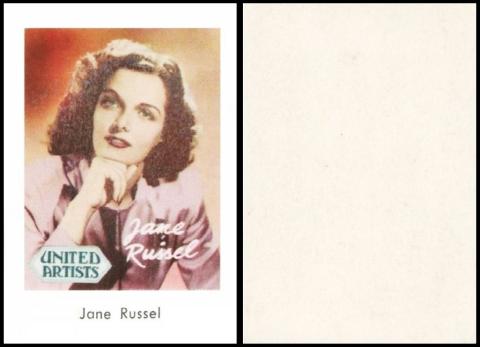
"Dutch Gum" [trade : gum : O/S - Holland] "Filmstjarne Bilder" / "Film Star Pictures" - set two (1956) Un/100
Today in 1921 saw the birth of Ernestine Jane Geraldine Russell. She was known mainly for her physique, exploited by Howard Hughes for his long-banned film "The Outlaw", filmed in 1941, but not released across America until 1946 - but there was much more to her than that.
She was born in Minnesota, the only daughter to an ex First Lieutenant in the Army and a travelling actress. They also had four boys, her brothers. For some reason, never fully explained, her parents came down from Canada, gave birth to her, and then went back to Canada when she was just over a week old. They then moved down to California about a year later.
It was in California that young Ernestine first took dance and piano lessons, and would eventually supplement her income, after her father`s death, by modelling for photographers.
This brought her to the attention of Howard Hughes, who signed her up in 1940 to a seven-year contract. Some say she was lucky, for she was very tall, at 5 foot 7, taller than some of the actors she worked with, but others say that this was more than compensated for by her vital statistics of 38-24-36.
She spent most of her early career on publicity tours, drumming up interest for "The Outlaw", but in 1946, with it still only on limited release, she took a role in a film called "Young Widow". It was not a success. She did not think that she would ever get on in the movies, so she decided to try her hand at singing, with the Kay Kyser Orchestra. She made two records with him and one on her own, but singing was not as exciting as she thought it would have been, though it is worth mentioning that she did a later record with another singer who briefly worked with Kay Kyser, Mr. Frank Sinatra - it was called "Kisses and Tears", and was released in 1950.
Before that she had a breakthrough, when she was cast as Calamity Jane in "The Paleface", released in 1948; a spoof of the western genre co-starring Bob Hope. It has been written that the main humour was that she was so much taller than him, but that is incorrect, he was actually an inch taller than her - though for the time it was unusual, as leading women tended to be quite a bit shorter than their leading man.
In the same year, Howard Hughes bought R.K.O. Pictures, and became her employer again. His first film with her was a musical, teaming Frank Sinatra and Groucho Marx; it was not a great success. Her next film was not great box office, but it was important, as it teamed her with rough, tough, Robert Mitchum, and they had instant on-screen chemistry, though he had been married in real life to Dorothy Spence, since 1940, and they would stay together until he died in 1997. The film was called "His Kind of Woman", and it was an early example of what would come to be known as "Film Noir". Sadly they were only teamed together once more, in 1952, on a film called "Macao". In that year she was also loaned out to Paramount Studios for a sequel called "Son of Paleface", again with Bob Hope. And she would also appear, briefly, in one of his "Road To" movies, with Bing Crosby - the "Road To Bali".
Her biggest commercial hit, though, was yet to come, and that was "Gentlemen Prefer Blondes", which teamed her with Marilyn Monroe. I am not sure it is a great movie, but it was definitely popular with fans, and remains so to this day. Musicals were also very suited to her singing and dancing talents, and the film does showcase that well. And it led to her next part, another Howard Hughes production, called "The French Line". This was a curious film, shot in 3-D, and co-starring Gilbert Roland, but it is notable for being the first screen appearance of Kim Novak.
From there she did her last film with Howard Hughes, before her contract ended in February 1954. This was "Underwater", released in 1955, a sub-aquan adventure with Richard Egan. It did well at the box office. Her contract with Hughes ended in February 1954.
Unfortunately the heyday of her career was in the 1940s and 50s, and so she appears on few cigarette cards. You will find a lot of her on "Dutch Gum" though, including our card, which is very unusual as it not only spells her name wrong but has a "signature" that repeats the same error.
She was married three times, firstly to the footballer Robert Stanton "Bob" Waterfield, who had been her high school sweetheart, but they divorced in 1968. She then married Roger Barrett, who died within the year. Lastly, she married John Calvin Peoples, in 1974, who died in 1999. She adopted three children, who gave her eight grandchildren and ten great grandchildren - and in 1955 she founded the first ever international adoption programme, called "Waif". She died at her home in California in February 2011.
This card comes from a set which is usually known as the "Studio" set, simply because it has the panel within the picture that gives the name of the film studio to which the star shown belonged. However several other sets have the studio shown as initials or as the full name, so it is more correct to call this the "Studio Panel" set. Though the packets call the set by another title entirely, that being "Filmstjarne Bilder", or film star pictures.
In addition, our card is also blank backed, whereas you can get the same cards with an printed back instead, which, rather intriguingly, advertises "Kellogg`s Corn Flakes, Rice Krispies, Socker Frosted Flakes, Sockris and Pep".
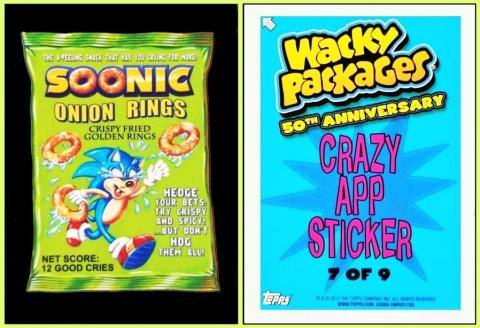
Topps [trade/commercial : cards : O/S - USA] "Wacky Packages - 50th Anniversary" (2017) 7/9
Today is National Onion Ring Day. And it is also National Kissing Day, but it may not be a good idea to combine the two.
I actually wrote that second one down because I thought that finding an onion ring on a card would be quite impossible, but look, I was wrong. And I am amazed.
I also remain amazed that the onion ring was invented in 1820 by John Mollard in a book called "The Art of Cookery Made Easy & Refined", for basically the onion ring is a simple thing, just a slice across an onion, of a reasonable thickness, then each ring popped out, (though it works better with the larger ones than the middle ones). This is then coated in either batter or breadcrumbs and fried - though at the turn of the twentieth century they seem not to have been dipped, just fried in their naked form.
As far as Sonic the Hedgehog`s connection with the onion ring apparently if, during the game, you allow him to eat them, he becomes fatter and fatter as he eats more and more. I am not sure quite how this helps him, but it is a salutary warning as to what happens to us, if we do the same !
This set is an update of the original Wacky Packages, to mark the fiftieth anniversary of their issue. They are parodies, and if you look closely our card shows "Soonic" the Hedgehog rather than Sonic, to avoid any lawsuits.
Our card is from the section "Crazy Apps" and I was going to insert a checklist, but there is a website devoted to this set and you can see the cards in person by clicking a link there - not just in this black format, but in the blue, the sepia, the yellow, and the bronze.
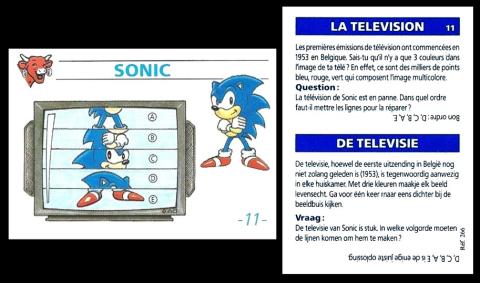
Fromageries BEL [trade : cheese : O/S - France] "Sonic Cards" (19)
Now this is not much of a segue from yesterday`s card, but I knew I would never find another card of an onion ring, and I could not find an alternative I liked for an event of today.
But I did confine the write up above, pretty much, to onion rings, and now I can talk more on the fact that today, in 1991, saw the release of the Sonic the Hedgehog video game.
The truth is that there would not have been a Sonic the Hedgehog if there had not been a Super Mario Brothers. For Mario the plumber gave Nintendo an icon, something Sega, their rivals, did not have.
It was a trio of Japanese game developers, Yuji Naka, Naoto Ohshima, and Hirokazu Yasuhara, who came up with the idea of a super fast hedgehog. Now hedgehogs are not native to Japan, which is why Sonic looks slightly odd to our eyes. And in fact Sonic was going to be a rabbit, but the ears were hard to animate successfully.
The first game was made available in 1991, and it worked only in the Sega Genesis system, which we know better as the Mega Drive. Since then, Sonic the Hedgehog has become one of the world`s best selling games, and also four movies.
The downside of his success it that it has led to real hedgehogs being imported and sold as pets in Japan, something they were not designed for. Then they are often discarded when they cannot be taught to perform tricks like Sonic. And so their lives are short, and sad.
On a brighter note we know a few of these cards - though be aware, as they are often confused with another set, also by Bel, known as "Mini Jeux" or mini games, mainly because the same images appear on those cards, but Sonic is in a slightly different place, and though the pictures are the same the games are oftenslightly different. In addition the sets are numbered differently, and on our set the back is bi-lingual, French and Dutch.
The "Mini Jeux" is complete in twenty-four cards, most of which I have found - but I am not sure about our set, as I have not yet found all the cards. For ease I have put the table in reverse, starting with the mini set, but once I have found all of our set (which are in bold type in brackets) I will make them the first column
- Le Telephone (12)
- La Pile
- La Television - De Televisie (11)
- L`Aeroglisseur
- Le TGV
- Le Telescope
- La Photographie - De Fotographie (4)
- Console Sega
- L`Ampoule - De Gloeilamp (8)
- La Radiographie
- La Fibre Optique
- Le Sous Marin
- La Telecarte
- Music
- L`Helicoptere
- Lecteur Laser
If anyone knows any others, or can fill in the Dutch titles, do let us know please.
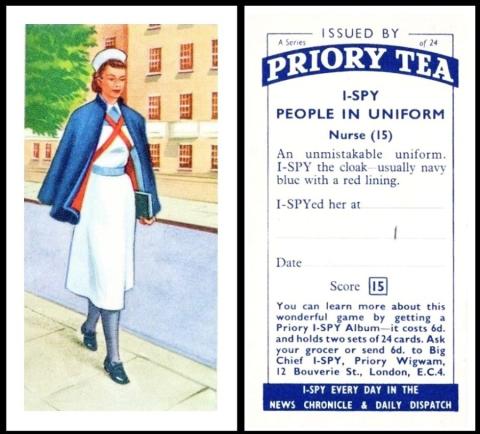
PRIORY Tea [trade : UK] "I-Spy People in Uniform" (1955) 15/24 - PRI-620 : PTT-3
Today is the centenary not of the "Five Sisters" window in York Minster, for it was built between built 1250 and 1260, but of its unveiling by the Duchess of York.
It was being re-unveiled for a rather curious reason. There had been a bomb, dropped from a zeppelin raider, quite nearby, and it was decided to remove the windows and put them into storage, just in case next time the bomb fell nearer. However when they were removed it was discovered that the glass was getting thin and holed, something which would never have been discovered if they had been left in place, until they just fell apart and crumbled over the floor. So they were not just stored, but it was planned that they be re-stored. Dreadful pun, I know.
Now we have to go back a bit in time, to meet Mrs. Helen Drage Little, who had gone with her husband to Egypt during the first world war and seen the men coming back wounded from Gallipoli. She remembered the way that the nurses came down and comforted them, and, after the war, wondered why when there were memorials to the men, the women, many of whom she knew had also lost their lives, were forgotten.
In 1922, she heard that the "Five Sisters" window was being restored, and she, along with a friend, Almyra Gray, who was a local magistrate as well as the former president of the National Council for Women Workers, and a proud suffragette, launched an appeal for local women to help with the restoration. She also first mooted the suggestion that the windows be dedicated as a permanent memorial to all the "sisters" who had lost their lives in wartime.
It only took nine weeks to go past the £3,000 which had been set as a target, and more than local women had joined in, women from all across the Empire were sending in little and large sums of money. Even Princess Mary sent £50. And so the windows were very well restored, and then unveiled by the Duchess of York, with a plaque to read that they were "Sacred to the memory of the women of the Empire who gave their lives in the European war of 1914–1918".
This, rather shockingly, remains the only memorial in the UK which is dedicated to the women of the First World War.
Now cards of women in war are also rare, and I have used most of the sets already, but maybe someone has an earlier, actual First World War nurse card, tobacco, trade, or silk, that they would like to donate a scan of the front and back for?
Until then, we have this, which shows a nurse in a blue cape. Now you may be surprised to learn that this would be instantly recognisable to nurses of the First World War. In fact there were no nurses uniforms until Florence Nightingale created a long grey tweed dress, and a scarf, along with the need to keep the hair back out of the way and the wounds. She was also the first to wear a belt with all the tools of her trade, fastened by a large silver buckle - something which has endured throughout nursing.
There were a few changes to the nurse uniform by the First World War. Blue was shown to need less washing than grey, and aprons were also introduced, which could be frequently changed with each soiling, rather than having to change an entire dress. The dresses also grew shorter and thinner, and military nurses, over a certain rank, were issued with a cape. The white dress, as shown here, would continue right into the 1980s. The one big change, and the defining item of the image, as far as dating it goes, was the hat, which came in with the 1950s and was gone by the end of the decade.
Now we have a home page for Priory Tea, which you can find with our Card of the Day for the 10th of July, 2024. On there is a listing of all their sets, and links to other places where they appear.
Sadly the description in our British Trade Index for the Priory sets is scant, and our set today is only listed as :
Priory Tea & Coffee Co. Ltd., London, S.E.1. Cards issued 1957-64. Small size 69 x 37 m/m. Special album issued to house the 13 series, listed below in order used in album. Series numbers appear only on album sheets.
- SERIES 3 "I SPY PEOPLE IN UNIFORM". Sm. Nd. (24) ... PTT-3
And this remains the text in our updated British Trade Index issued in the year 2000, save a new card code, of PRI-620
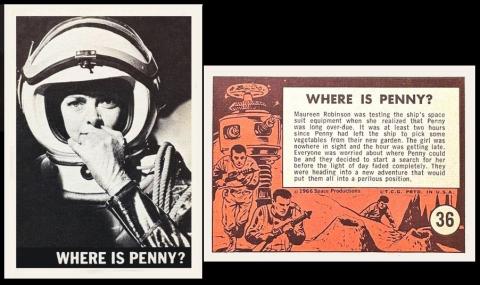
Topps [trade : bubble gum : O/S - USA] "Lost in Space" (1966) 36/55
Today we celebrate June Lockhart, born today in 1925, and celebrating her hundredth birthday.
She was born in New York City, into a famous theatrical family - her father being Eugene Edward "Gene" Lockhart, playwright, singer, and lyricist, who appeared in more than three hundred films and was nominated for Best Supporting Actor for "Algiers", but the statue was held aloft by Walter Brennan, in a very close contest involving John Garfield, Robert Morley and Basil Rathbone. Her mother was also an actress, of English descent. And her paternal grandfather was John Coates Lockhart, who had been born in Scotland and toured, right across America.
Her first appearance on film was with her parents, in "A Christmas Carol" in 1938. However she had already appeared several times on stage, starting when she was eight.
As for the role that made her name, that was "Son of Lassie", released in 1945, in which she played the romantic lead - and she would also, later, be a prominent part of the television version, but, now, only just later than ten years on, she found herself playing the mother of the young boy who befriends Lassie.
This almost certainly led to her playing another mother, Doctor Maureen Robinson, but also a biochemist, who, as mentioned on our card, manages to still maintain a garden in outer space. Now we tend to think of this as a very long running series, but the first run was only eighty-three episodes, over three years, between 1965 and 1968.
It was a curious series, actually based on "Swiss Family Robinson, written in 1812 - but instead of landing on an island, they were marooned in space.Yet again, the makers failed to look too far ahead, and the space ship blasts off on October 16, 1997. Before it hit the tv screens, though, it had been a comic, called "Space Family Robinson". It was quite popular and someone bought the rights to turn it into a television show. There is some confusion about what happened next, but we know that the owner of the rights did sue the CBS network, and that the comic book was renamed to "Lost in Space". But I have not yet discovered what happened in the lawsuit or whether it was settled out of court.
One thing we must mention is that the series had music by Johnny Williams, making his debut, before he would go on to worldwide fame for composing theme tunes for E.T, and Star Wars.
Though the series was cancelled after the third season, it remained popular, and a feature film was released in 1998 starring William Hurt, Mimi Rogers, and Matt Le Blanc - plus Gary Oldman as Dr. Zachary Smith - and June Lockhart as Principal Cartright.
This inspired two television series, in 2004 and 2018, the latter of which is made for netflix, and in which, thrillingly, she also appeared - in one episode, screened in 2021 - as the voice of Alpha Control.
She married twice, to John F. Maloney in 1951, but the marriage ended in divorce eight years later, and to John Lindsay in 1959, which also ended in divorce, but lasted longer, some eleven years. She had two children during her first marriage, the actress Anne Lockhart (who is chiefly remembered for appearing the original version of Battlestar Galactica) and June Elizabeth, who seems, perhaps wisely, to stay out of the limelight.
This set comes from a time when bubble gum was still included with the cards, and each pack cost five cents. There is a range of colour variations to front and back, which is sometimes said to be a result of being in the pack with the gum for a long time, or is alternatively explained by it having a long run and being re-printed on a slightly different board stock to the original.
For some reason card one is the hardest to get. This does not seem to be because of the usual theory, about rubber bands damaging the top and bottom card, because card no. 55 is pretty common.
Two things to look out for. The bad is that there are a few unofficial reprints out there, which seem to have been made for fan conventions and were never intended to enter the cartophilic world, but sometimes these are sold at fairs by general dealers for catalogue prices. The good is that at the same fan conventions, it came to be a thing to take an old card and get it signed by the star, and these are reasonably easy to acquire at a fair cost.
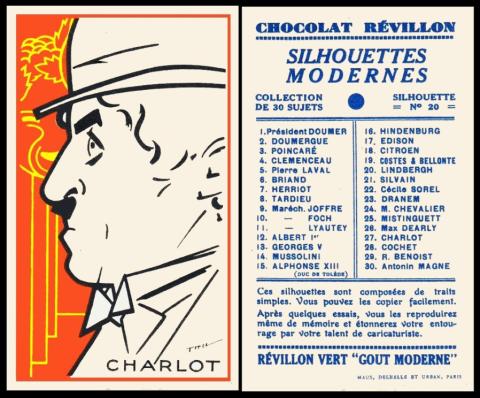
Chocolat REVILLON [trade : chocolate : O/S - Coteau, France] "Silhouettes Modernes" (1920) 27/30
Today, another centenary, of the Chaplin film "The Gold Rush", which received its premiere today in 1925 at the Grauman`s Egyptian Theatre.
This was written, directed, and produced by Mr. Chaplin, and is still one of his best remembered. He also stated, several times that it was the film he hoped to be remembered for.
Ostensibly, the film is the story of a man who heads to the Klondyke, hoping that striking gold will change his fortunes. He researched every facet of the story, even that before the Donner Party had set to eating each other they had eaten their boots. He plays it for laughs, luckily, and eats his boots, including the laces - both boots and laces being made of licorice. Reportedly to film the entire scene saw him munch through twenty pairs of licorice boots, for which I am sure he suffered later.
Another much loved scene is the dance of the bread rolls, often imitated but seldom bettered - I am very partial to the version in a much under rated film called "Benny and Joon" with Johnny Depp in an early performance.
The leading lady started out as Lita Grey, but she became pregnant before filming started, to Chaplin, and so the role was recast with Georgia Hale. For a while Carol Lombard, (before she became Carole), was also in the running for the leading lady part.
The original won few awards, but in 1942 it was re-released by Chaplin, with additional sound effects. This is almost certainly one of his attempts to keep his name before the public as he grew older, for he was terrified of being forgotten. And it did receive an Academy Award nominations for Best Musical Score, but the award went to the Bette Davis film "Now Voyager".
By the way if you want to watch the entire movie, it is available through You Tube....
Cards showing the film are very few and far between - the only one I know of that was issued in his lifetime is card 112 of "El Cine" by Saint Hermanos of Uruguay, and that shows him eating his boots. However the card says it is a scene from "Monsieur Verdoux". That set was issued in 1954.
In more recent years a few more have come along - on the 1991 Victoria Gallery`s set of "Legends of Hollywood", card 5 shows him with the blanket around his shoulders as the inset picture on the side of the frame. And card 65 of Breygent`s "Classic Vintage Movie Posters" (2009) shows a poster of the film, but, curiously, not the most usually seen one where he is huddled beneath his blanket trying to keep warm.
and now just one day remains, to do tonight
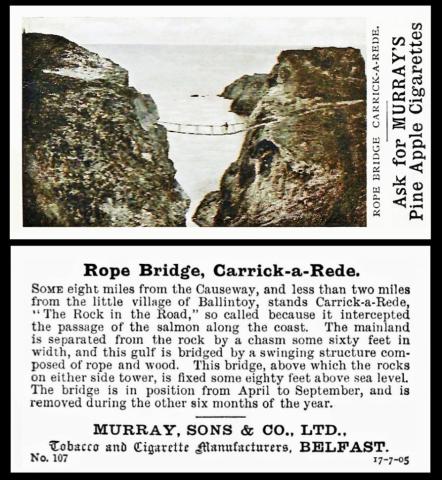
MURRAY, Sons & Co. Ltd. [tobacco : UK - Belfast, Northern Ireland] "Irish Scenery" (July 1905?) No.107 - M164-2.B
This card is a bit of a tangent, but a fun one.
For today is #NationalPineappleDay, and #InternationalPineappleDay - and you can actually read how it all started online, as well as how it got its alternative hashtag of #InternationalBringYourPineappleToWorkDay
Now at one time if you had a pineapple on your table you were pretty well off, for they were tropical fruit, which came from South America. This must have been the case in Asia too, for if you take someone a pineapple it stands for prosperity and good fortune.
The actual fruit only came to Britain in the seventeenth century, though they were known in literature before that, for a similar fruit was written about in the sixteenth century translation of a travel book, called "The New Found World, or Antarctike" - as a food of the people who used to live near what we now call Rio de Janiero. The fruit is referred to in several different ways, as a "Hoyriri", and then as a "Nana", which is where we get the French word for the fruit "Ananas". The first time "Pineapple" was used was in 1714.
Today we eat pineapple not to show off - or hopefully not, anyway - but because of the health benefits it brings our bodies. It is full of Vitamin C and packed with nutrients, which revitalise our tired immune systems, nourish our skin, replace fluids lost by perspiration or disease, and also their bright colour encourage jaded appetites to tuck in.
Today`s card is from a set making its first illustrated appearance on our website, though we have mentioned it before, briefly, with our Card of the Day for the 21st of April, 2024. That covered "The Story of Ships” (1939) , and it is also where you will find an ever growing biography of the firm.
It first appears in our original World Tobacco Issues Index as :
IRISH SCENERY. (A). Sm. 69 x 38. Sepia. Back inscribed "17-7-05". Nd. 101-125 (25) ... M164-2
- A. Front "Ask for Murray`s Hall Mark Cigarettes".
- B. Front "Ask for Murray`s Pine Apple Cigarettes".
- C. Front "Ask for Murray`s Special Crown Cigarettes".
- D. Front "Ask for Murray`s Straight Cut Cigarettes"
- E. Front "Ask for Murray`s Yachtsman Cigarettes"
So, before we dash on, I am sure you are wondering the same as me, and that is whether the 17-7-05 on the bottom of the reverse is actually the date that this set was first issued. The truth is we do not know for sure, but we do know that the set was issued in 1905, which covers the final two digits. So it is not inconceivable that the 17-07 means the 17th of July.
As for why this set is numbered from 101-125, that is also unknown. There is only other set that we know to have been issued by Murray between the years of 1901 and 1905 was “Actresses BLARM” - but that was just twenty cards, also issued by several other companies, hence the acronym of BLARM, made up of the initials of some of the issuers, in order to identify the set.
Anyway, by the time of our updated World Tobacco Issues Index, the above listing has been shortened, and reads :
IRISH SCENERY. (A). Sm. 69 x 38. Sepia. Back inscribed "17-7-05". Nd. 101-125 (25) ... M970-075
Front "Ask for Murray`s" A. Hall Mark B. Pine Apple C. Special Crown D. Straight Cut E. Yachtsman "Cigarettes"
This week's Cards of the Day...
have been adding more images to our calendar of cards - these being ones which were first issued in the month of June.
A few statistics :
The earliest card we have tied to this month is Wills "Borough Arms" which was recorded in the Wills Works magazine as having been issued in June 1904, though there were actually eleven sets under that umbrella, and not all of them could have been issued in that one month.
The latest card proven to have been issued in this month, that was also by Wills, namely "Garden Flowers - New Varieties" second series (large size), issued in June 1939.
The most popular June for card issues was 1912, with seven issues :
- Smith "Cricketers"
- Wills "Birds of the East" - `Ruby Queen` brand
- Wills "British Empire Series" - `Capstan` brand
- Wills "British Empire Series" - `Vice Regal` brand
- Wills "Signalling Series" - `Capstan` brand
- Wills "Signalling Series" - `Vice Regal` brand
- Wills "Types of the British Army" - `Flag` brand
The runner up was June 1930, with six issues :
- Churchman "Nature`s Architects" (large size)
- Churchman "The Story of London" (small size)
- Churchman "The Story of London" (large size) [in newsletter, scroll down to Tuesday 23 January]
- Faulkner "Old Sporting Prints"
- Player "Treasures of Ireland"
- Wills "Irish Holiday Resorts"
On the other hand we have not yet found any cards issued in the Junes of 1907, 1932, and 1935 - and there is also a gap, caused by the First World War, between the June 1917 Wills` set of "British Birds" and the June 1923 Wills` set of "Arms of Universities"
Saturday, 14th June 2025
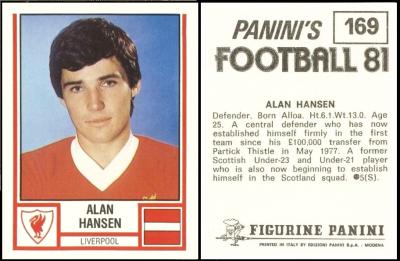
This clue was a bit of a tangent, as it was not, as far as I know, issued in June - but it does show an extraordinarily young Alan David Hansen, and he was born on the 13th of June, 1955.
However it is not his "Rookie" card - which is stated by many collectors to be Topps Footballers (Scottish, Yellow backs), issued back in 1977, on which he is playing for Partick Thistle.
He was born in Sauchie, Scotland. and his first football team was Sauchie Juniors. After he left them, he almost changed sport, to golf, but his family wanted him to return to football and got him a trial with Hibernian, though he actually turned down joining the squad as he did not want to give up the golf.
However, in 1973 he signed for Partick Thistle, and also played for his country, Scotland, in the Under 23 squad. He stayed with them until 1977, when he signed for Liverpool, and he was there right until 1991, making almost five hundred appearances, as well as playing for Scotland on the senior squad.
He then retired, and began a second career, commentating on football for radio, and then for television, including many appearances on Match of the Day.
This card may be replaced as we have used this set before. So I will sort that out and then wax lyrical about this set on whichever one I decide to keep - which will be based entirely on which I can replace most easily... Watch this space!
Panini`s "Football 81" was a mixture of sticker styles. Cards one and two were Terry McDermott of Liverpool and Davie Provan of Glasgow Celtic. But I have no idea why? Maybe a footballing fan can enlighten me?
I did start to tell you how the set developed, but I will scratch that, for I have now been told you can see most of these cards at Last Sticker.com/Panini8081
There is a rather curious fact this set, which, though devoted to players of English and Scottish clubs, was somehow also issued in Canada and South Africa.
And, odder still, it was also issued in Switzerland, or so it appears, but if you look into that set it is only the name "Football 81" which remains the same, the stickers, of which there are four hundred and two, are all of Swiss teams.
Perhaps there are other varieties too - so if you know of any do let us know.
Sunday, 15th June 2025

This card is the second card on our calendar of known June issues - but it had actually already been issued, by Churchman, in October 1904.
This is another set with a complex story, not that you would know this from the entry in our original World Tobacco Issues Index, which just says :
- BEAUTIES - "CERF". (A). Sm. Unnd. (12). See H.57. ... E14-13
This is unaltered, too, in our updated version of this volume, save for a new card code, of E265-260.
The big story comes if we follow the trail of the "H" code. Now with the original World Tobacco Issues Index, that leads us to the original London Cigarette Card Company Handbook, published in 1950, and bound uniform with the catalogue of that year. The Handbook shows all twelve cards, and reads :
- H.57. BEAUTIES - "CERF". (adopted title). Code letters taken from Churchman, Edwards, Ringer & Bigg, Franklyn Davey. Fronts in colour. Unnumbered series of 12, illustrated in Fig.57
Pre-1919 - Churchman
Edwards, Ringer & Bigg
Franklyn Davey
Thanks to the catalogue which accompanies this volume, we know that the Churchman version was issued in October 1904 (and retailed, in 1950, at between 17/6 and 50/- a card, or £30 for a complete set) - that the Edwards, Ringer & Bigg version was issued a few months later in June 1905 (and retailed, oddly, for less - odds being between 10/- and 30/- , and sets at just £20) - and that the Franklyn Davey version was circulated in 1905, without a month being recorded (and retailed at between 12/- and 35/- for odds and £22 for complete sets).
The fronts are identical in both sets, save the maker`s names, and only that one word "Churchman`s" (or "Ringer`s) alters. However the backs are very different, as the Churchman version is completely blank. And as for the Franklyn Davey one, that says "Loadstone" in the space - and it actually has an advert back.
Now the "H" code in the updated World Tobacco Issues Index leads us somewhere else, that being our own Handbook. This also adds a twist, for the listing reads :
- H.57. BEAUTIES - "CERF". (adopted title). Code letters taken from Churchman, Edwards, Ringer & Bigg, Franklyn Davey. Fronts in colour. Unnumbered series of 12, illustrated in Fig.57.
An anonymous set, possibly proofs, is known, with plain back and an empty name panel at the base of the front.
Pre-1919 - Churchman
Edwards, Ringer & Bigg
Franklyn Davey
This also has pictures, but they are darker than the ones above, possibly because they were copied from that volume. I may even find the original block, one day, which would have appeared in a copy of the London Cigarette Card Company`s "Cigarette Card News".
Monday, 16th June 2025
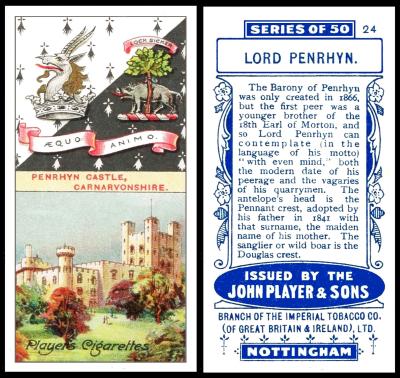
This card was born in June 1906, two years after the one above, but it is very different, much more crowded to the front, and also the back is now a descriptive text.
Here we have Penrhyn Castle, in North Wales, a building which is much younger than it looks, for it replaces a fifteenth century manor house. That was still in place when the Penrhyn estate was acquired by Richard Pennant, the first Baron Penrhyn. There is confusion as to how he came to get the land, some say through his father, and others that it was connected with his wife; whilst there are also rumours that it was acquired not entirely legitimately, in connection with one of the slave plantations he owned in Jamaica. You could say that he seems to have had more heart for the local area, as he pretty much set up the slate mining industry in the area - or, alternatively, that this was another kind of slavery.
Anyway, towards the end of the eighteenth century. he decided that he wanted a better house. That was built, incorporating parts of the former manor house, but this is not it, for when he died, in 1808, his second cousin inherited the estate. His name was George Hay-Dawkins, and he dropped the Hay part and took on the Pennant part of his relative`s name. And he also kept the antelope crest which appears on this card. Most of all he added to the castle, the large tower, as seen on our card, designed to look like a Norman castle. In fact this tower is a copy of the castle at Hedingham in Essex.
It took fifteen years to build, starting in 1822. It was also expanded quite a bit about ten years into the build, when the owner was compensated for having to give up his interests in the West Indies as part of the Slavery Abolition Act. This included lands, but also the ownership of almost eight hundred slaves, men, women, and children.
Before it was finished, however, he gave the estate to his new son in law as a wedding present. He was the "Douglas" quoted on the back of this card, a Grenadier Guard, who added the crest of the boar by the tree, and the unusual motto "Lock Sicker", which means "Keep secure". He also added his wife`s surname, or the Pennant bit, anyway, to his name, making the family name Douglas-Pennant.
The new owners, thankfully, were not permitted to keep slaves, but they seem to have tried to add a number of impositions on to their slate workers, and were vehemently opposed to any whiff of Trade Unions, so their quarries were frequently closed due to strikes. The longest of these lasted for three years, and still holds the record for the longest industrial action.
It does not seem as if this couple had any children, for, in 1866, the estate went to someone who seems to have been quite a distant relative. He had the castle for only twenty years, and then died, but he had a son, who took over, and who lost several members of his family during the First World War. One of them, at least did survive, and he took over the castle until the late 1940s, at which time it was left to a niece. But she seems to have also died, very shortly after, and, without anyone to leave it to, or to pay her bills, the castle, and a large proportion of the estate, was acquired by the National Trust in 1951, via the Treasury, in lieu of death duties.
I have been waiting to use one of these cards for a while, but it is a complex set and better as a Card of the Day, at least as far as the first fifty cards are concerned.
The first thing about the set is that it has no title, "Country Seats and Arms" being the title chosen for the set by early collectors in order to classify it.
In addition, the second series was definitely reprinted, at least twice, and it is probable that the first, and possibly the third, were too.
Then there is an anomaly with the date, our original reference book to the issues of John Player quoting May 1909, and the London Cigarette Card catalogues quoting June 1906.
Anyway let us start the card chat with our original John Player reference book, RB.17, issued in 1950. This lists all three sets together, as :
- COUNTRY SEATS AND ARMS (adopted title). Small cards. Fronts in colour. Backs in blue, with descriptive text. Home issues.
56. 50 Series of 50. Numbered 1-50. Issued May 1909.
Error card - No.9 (a) ROSNEATH (b) ROSENEATH
Minor caption varieties have been reported, at No`s 7, 10, 21, 38, 42, 44, 48
57. Second Series. Numbered 51-100. Issued May 1910.
A. First printing - Nos. 51-75 only
B. Second printing - Nos. 51-100
The two printings can be distinguished as follows :-
First printing (caption in two lines).
Second printing (caption in one line)
Nos. 51-55, 58, 59, 64, 66, 67, 69-84, and 86-100.
In other cases both printings bear captions in two lines, and the distinctive difference occurs in the alignment of letters in the second line of the caption.
58. Third Series. Numbered 101-150. Issued September, 1910
This is slightly altered in our World Tobacco Issues Index, to :
- COUNTRY SEATS AND ARMS (A). Sm. ... P72-30
1. "Series of 50". Nd. 1/50.
2. "Second Series". Nd. 51/100. Two printings of Nos. 51/75, see RB.17/57
3. "Third Series". Nd. 101/150.
And in our updated World Tobacco Issues Index it appears exactly as above, but with a new card code, of P644-070.
As far as retail values, the three sets were listed in the 1950 London Cigarette Card Company 1950 catalogue as follows :
- first series - odds 1/- to 1/6, sets 70/-
- second series
first printing - odds 1/- to 3/-, sets £4
second printing - odds 9d. to 1/6, sets 70/- - third series - odds 9d. to 1/6, sets 70/-
Tuesday, 17th June 2025

We mentioned this set in conjunction with another set, Wills` "Auction Bridge" (July 1926), so it is pleasing to be able to show you it, at last.
Contract bridge is a development of Auction Bridge, but it seems to have become more popular, almost immediately. It still uses a single deck, and is played by four people, but they double up as teams. However it still involves these players bidding in an auction, over the number of tricks that the other side must win in order to win the entire game. There is a difference, about the scoring, but it is not easy to understand - so if there is a bridge player reading this who would like to simplify them, please do!
Its first appearance comes in our original Churchman reference book, RB.10, published in 1948, as ;
- 34. June 1935.
50. CONTRACT BRIDGE by "Slam" (titled series). Size 2 11/16 x 1 7/16" or 67 x 36 m/m. numbered in words on front and back 1-50. Fronts printed by letterpress, 4-colour half tone process. Backs in black, with descriptions (continued from fronts). printed by Mardon, Son & Hall.
Its next appearance is in our original World Tobacco Issues Index, much reduced, to ;
- CONTRACT BRIDGE. Sm. Nd. (50) ... C82-40
And this remains the same in our updated cersion, save a new card code, of C504-450
Wednesday, 18th June 2025
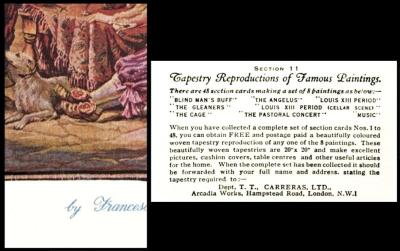
Sadly we have no reference book devoted to Carreras issues, so the only listing of this set appears in our original World Tobacco Issues Index, as :
- TAPESTRY REPRODUCTIONS OF FAMOUS PAINTINGS. Sm. 70 x 41. Sectional. Nd. (48) ... C18-69
This is repeated in our updated version, but with a new card code, of C151-385.
There are eight paintings, each of six sections, and they are listed on the back, but not the artists, which I have added below as there are actually only three, namely ;
- Francois Boucher (1703-1770)
"Blind Man`s Buff"
"Music"
"The Cage"
"The Pastoral Concert"
- Francesco Vinea (1846-1904)
"Louis XIII Period"
"Louis XIII Period (cellar scene)
- Jean-Francois Millet (1815-1875)
"The Angelus"
"The Gleaners"
The backs also tell us that "When you have collected a complete set of section cards nos 1 to 48 you can obtain FREE and postage paid a beautifully coloured woven tapestry reproduction of any one of the 8 paintings." These tapestries measured 20" x 20".
The strange thing is that these cards are pictures of tapestries, whereas the originals were paintings. This means that they must have made the tapestries, then used them to make the cards.
Hopefully they then neither made too few or too many, because I have to say that in 1938 tapestries were not exactly "on trend" with the general public. There seems to have only been one main collector, Urban Huttleston Rogers Broughton, 1st Baron Fairhaven, who was born in 1896. He, for some reason, took quite a fancy to them and used them to decorate Anglesey Abbey. His passion was the seventeenth century ones, but he also liked them so much that he had other, modern ones made, including a view of his home.
Whether this suggested the idea for this set is not known, but it seems curious that although he had collected tapestries since the 1920s, it was only after his brother`s marriage in 1932 that he was able to enlarge the property, including a grand library in 1937, where many of the tapestries hung. So it seems possible that this may have been featured in the papers, and perhaps did suggest the idea to Carreras.
Thursday, 19th June 2025
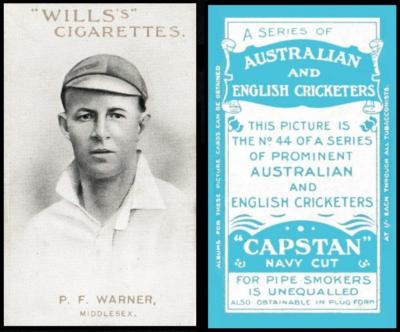
We have mentioned Mr. P. F. Warner before, in our newsletter of the 5th of April, 2025 - but only in respect of Wills` "Cricketer Series, 1901, for our Wills reference book part two lists that set with a revelation, telling us "Card No. 45 describes Mr. P. F. Warner, whilst the picture is actually that of Mr. G. E. Winter. No corrected card is known." By the way, what they mean by "describes" is not a descriptive text, it just means they have the name of Mr. Warner beneath a picture of Mr. Winter.
His name was actually [Sir] Pelham Francis Warne, MBE, and he was born, in Port of Spain, in Trinidad, on the 2nd of October, 1873. His mother was Spanish, by the name of Rosa Cadiz, and she must have worked more than a bit of magic on the rather staid Charles Warner and his English Colonial Family. Rather sweetly, the baby was usually referred to as "Plum" (a shortening of his first name). He was schooled, at first, in Barbados, then he was shipped off to Rugby School and thence to Oxford, where he first played cricket.
His brother, Aucher, was also a cricketer, but for the West Indies side and for Trinidad. It does not look like they ever faced each other on the field though, more is the pity.
Our man played in fifteen Test Matches, starting in 1899 against South Africa. And his greatest triumph was with a most spirited reclaiming of the Ashes, in 1903-4, after which he was named Wisden Cricketer of the Year. He was, most unusually, also given that honour in 1921 - for captaining Middlesex to the County Championship - for this is meant to be but a one time event in a cricketing career. Though there is one other also named so twice, and that was Jack Hobbs.
After his retirement as a player he became a manager, the chairman of the test selectors for England, and then President of the M.C.C. And he was knighted, for services to cricket, in 1937. These did not only include on the field of play, for he was a keen writer on the sport, founding "The Cricketer" magazine in 1921, and remaining editor until 1963. And he was also a very popular cricket correspondent for several newspapers.
He also had a very happy marriage, since 1904, resulting in three children. And he died in 1963, aged eighty-nine, in Sussex.
As to his card, well, I was rather confused about this set, but after I tracked it down in the reference books it made more sense. The problem is that it is listed under "Cricketers - Australian Issues" without the word "Prominent". There is also a picture of all the backs, which makes it clearer, but I will insert that elsewhere, as one of the group has already been featured as the card of the day for the 31st of March, 2024 - and it is further up the list of variations (as 59.B) than ours. So, until I feature a card from 59.A, that will be the home page for that group.
The text for our set reads :
- 59.J 59 Prominent AUSTRALIAN AND ENGLISH CRICKETERS. Size 61 x 36 m/m. Numbered on backs. See Fig. 41.J. Fronts printed in letterpress in black and white. The series was originally issued as one of 50, with two printings - "Capstan" and "Vice Regal" backs. The "Vice Regal" printing shows much variation in the shade of black. Both printings were inscribed "A Series of 50". Subsequently, Nos. 1-50 were reissued, again in two printings - "Havelock" and anonymous backs and both were inscribed "A Series of ". Finally, the "Capstan" and "Vice Regal" printings were reissued as a series of 59, cards 1-50 being inscribed "A Series of " and cards Nos. 51-59, "A Series of 59"
The nine additional cards provide a clue to the date of issue - all nine subjects were members of the M.C.C. team which toured Australia in 1911-12. The names of the members of the team would have been announced in August, 1911. It appears likely therefore that the first 50 subjects (which include a number of English cricketers) were prepared for issue at the opening of the Australian Cricket Season (October, 1911) and the nine additional titles which cover the members of the visiting English team not included in the first 50 cards would probably have been added a month or two later; the series would thus appear to be a 1911 issue.
SUMMARY
A. "Capstan" advertisement, backs in BLUE.
(a) Nos. 1-50 headed "A Series of 50",
(b) Nos. 1-50 headed "A Series of "
(c) Nos. 51-59 "A Series of 59"
B. "Vice Regal" advertisement, backs in PINK-MAUVE.
(a) Nos. 1-50 headed "A Series of 50",
(b) Nos. 1-50 headed "A Series of "
(c) Nos. 51-59 "A Series of 59"
C. "Havelock" advertisement, backs in OLIVE. Nos. 1-50, headed "A Series of "
D. No brand advertised, backs in GREY. (Anonymous issue). Nos. 1-50 headed "A Series of "
There is much colour variation in backs, especially in A and B.
By the way part four only adds a change to 59.F, and part five to 59.E - and we will add those in when we feature those cards.
Before I race on, the way that the above is written makes it seem like there is a large gap after "A Series of ......" but if you look at our card, nothing looks awry, it is only noticed if you already have the other printing. In fact I am not sure why the entry in the reference book did not just say "A Series of".
As for the date, that is supplied by Wills` Works Magazine, where our set is recorded as having been issued in June 1911. And all three brands were recorded as having been issued at the same time. But the fact that this is recorded means that the cards were printed in England and exported to Australia - and the only other Cricketers sets in this group which can claim that are 59.H and 59.I, issued in July 1907 - which, curiously, also carry the word "Prominent".
Now by the time of the World Tobacco Issues Index, the sets are under section 3 of the Wills listing, for Australian Issues, and sub-section 3.A, for issues between 1901 and 1917. In there our set appears as :
CRICKETER SERIES (A). Sm. ... W62-221
- 7. 1911-1912 issues. Titled "Australian and English Cricketers"". Size 62 x 36. Black and white. Nos. 1/50 headed "A Series of 50", Nos. 51-59 headed "A Series of....." See W/59.J
A. "Capstan" back (59)
B. "Vice Regal" back, in shades of pink or mauve (59)
C. "Havelock" back (50). Brand issue
There is a bit of a change to the entry for this set in our updated World Tobacco Issues Index, and the entry now reads :
CRICKETERS SERIES (A). Sm. ... W675-347
- 7. 1911-1912 issues. Titled "Australian and English Cricketers"". Size 62 x 36. Black and white. Nos. 1/50 headed "A Series of 50", Nos. 51-59 headed "A Series of....." See W/59.J
A. "Capstan" back in blue. Nos. 1/50 headed
(a) "A Series of 50"
(b) "A Series of " .
Nos. 51-59 headed "A Series of 59"
B. "Vice Regal" back in shades of pink or mauve. Back varieties as for "Capstan".
C. "Havelock" back in olive (50). Front (a) with (b) without (brand issue) "Wills` Cigarettes"
As for the missing set, the anonymous one, that is actually recorded at the back of the original World Tobacco Issues Index, with the "Z" codes, under "Anonymous issues (1) - with letterpress on back", sub-section b. for "Australian issues". However, the heading for that section tells an interesting tale, that they were "inscribed with album wording "... at 1/- each through all tobacconists", except Set ZA3-7, [which was] inscribed "Presented to Smokers of these Cigarettes". Small size 67 x 36 m/m, unless stated. Issued by B.A.T.".
The listing for the set reads "AUSTRALIAN AND ENGLISH CRICKETERS. Sm. 63 x 36. Black and white. Nd. (50). See W/59.J ... ZA3-2". And that is identical in the updated version, save a new card code, of ZA03-080.
Friday, 20th June 2025

This is a curious little set, really well coloured, and yet I have never come across it before.
Even in our Wills reference book it has but a scant description, of :
- 300 RACES OF MANKIND. Size 62 x 37 m/m. Fronts lithographed in colour, gold background, blue borders. Backs in green, with star and circle trade mark, no descriptive text. General Overseas Issue, between 1905-1910.
When these books were reprinted, as one, beneath a hard cover, in the 1970s, they were enhanced by the addition of a list of dates, supplied from the Wills1 Works Magazine, and that tells us that this set was actually issued after that, in June 1911, which, coincidentally, was the same month as the set we featured yesterday - just in a slightly different part of the globe.
In our original World Tobacco Issues Index it appears under Wills section 5, for "Other Export Issues. Cards without I.T.C. Clause, issued through B.A.T. Small size 67-68 x 36 m/m, and inscribed "W.D.& H.O. Wills", unless stated". The heading for the sub section, 5.A, adds that these were "English Language Issues, 1901-17. Issued chiefly in Channel Islands, Malta, India and Malaya."
Sadly, the entry is even shorter, just :
- RACES OF MANKIND. Sm. 62 x 37. Nd. (50) ... W62-423
And this text is identical in the updated version, apart from a new card code, of W675-602
and there you go, we made it, with most of the descriptions. They will be fettled as I work through the gallery and index, which I am now returning to.
Time now, to turn in, and maybe sleep.
